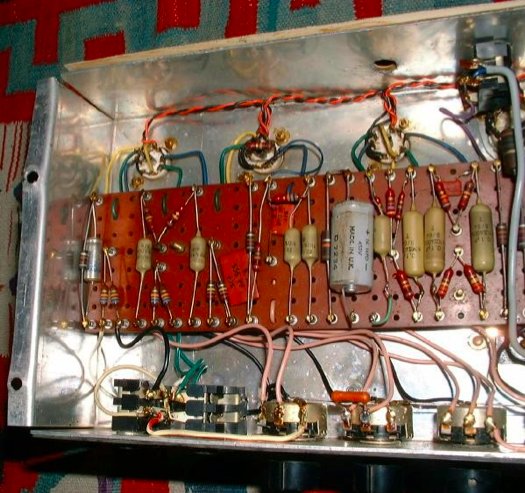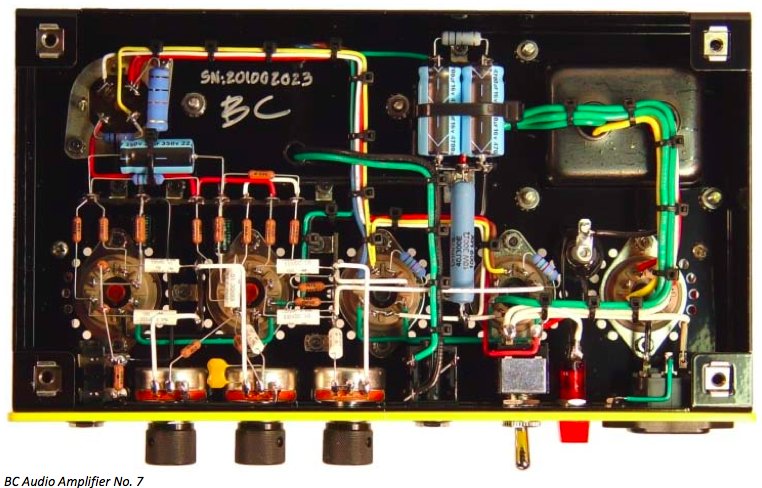This is a Guest Post by Bruce Clement of BC Audio
I am often asked why I use what I refer to as true point-to-point wiring in my amps. Why go through the extra work? Does it really make a difference in the sound? While point-to-point wiring is certainly not the only path to great tone, I’d like to address some of the questions surrounding the topic and explain why point-to-point wiring is important to me.
Q: What do you mean “true point-to-point” wiring? Aren’t most vintage and boutique amps point-to-point?
A: Long before the invention of the printed circuit board (PCB), when eyelet boards and turret boards were new advances, the term point-to-point referred to the then common method of soldering small electronic parts (such as resistors and capacitors) directly to chassis-mounted parts (tube sockets, jacks, pots). “Point-to-point” meant the resistors, capacitors and wires in the amp connected one point to another, without a board of any kind.
With the resurgence in popularity of vintage amps – most of which were built using turret or eyelet boards – many people began to refer to those amps as “point-to-point.” I believe this error occurred because people were trying to make a distinction between what you see in vintage amps – and the boutique amps that copy them – and the PCBs found in modern mass-produced amps. Thus, “point-to-point” came to mean “anything other than PCB.”
There certainly is a distinction to be made between eyelet or turret boards and PCBs. But, the misapplication of the term point-to-point to these board-based construction methods has resulted in a loss of its correct meaning. That’s why I have taken to saying “true point-to-point.” It’s not that other methods are less “true” to some ideal, but that the original meaning of point-to-point has been lost. To their credit, many manufacturers today are using terms like “hand wired” to describe their turret board or eyelet board amps.
Q: What does this mean in practical terms? What’s the difference?
A: Let me point out the primary difference between board-based and point-to-point construction: wires.

In a board-based tube amp, such as a vintage Fender or Marshall, many wires connect the parts on the board to the chassis-mounted tube sockets, jacks, pots and other parts. Any signal-carrying wires running from one place to another have the potential for the introduction of a myriad of problems: noise, interference, crosstalk, coupling, parasitic oscillation, unwanted capacitance and instability. That’s why lead dress – the way wires are arranged and managed throughout an amp – has always been such a huge factor in tube amplifier design.
With point-to-point wiring, many of these wires simply don’t exist.

For example, let’s take a look at the most sensitive, vulnerable part of any amp – the place where the problems mentioned above can have the most detrimental effect: the input to the first gain stage, where the guitar signal first reaches a tube. Whatever problems get introduced here are amplified and re-amplified throughout the rest of the amp.
In a board-based amp, a wire runs from the input jack to the board, where it connects to a turret or eyelet. A resistor is mounted between that turret/eyelet and another one. From there, a second wire runs to the tube socket. Each of these two wires is likely to be several inches long, and located physically close to other wires that carry amplified signals, B+ power, heater power or other currents. This type of arrangement is repeated again and again – at each gain stage, each front panel control, each part of the signal path.
Now, consider the input to the first gain stage in BC Audio’s high-gain 25w Amplifier No. 8. The input jack is connected to the tube socket by a resistor alone (arrow in photo). There is no wire between the jack and the resistor, nor is there a wire between the resistor and the tube socket.

This technique is carried on throughout the circuit. There are only a few very short signal-carrying wires in the entire signal path. Other wires safely carry B+, heater and other currents some distance away from the sensitive areas of the amp.
Q: Isn’t point-to-point wiring messy?
A: This particular criticism is one that I happen to agree with. Traditionally, point-to-point wiring is messy! There’s an old yarn, “If you can see the tube sockets, it’s not point-to-point.” I’ve seen many circuits like that, with parts overlapping other parts at every angle, several layers deep, a veritable mish-mash of electronics so haphazard-looking that it’s a wonder the thing even works!
Well, I don’t like that kind of mess any more than anyone else. That’s why I’ve developed a different approach to point-to- point wiring. I have laid out parts along clean, parallel and perpendicular lines wherever possible. Wires are neatly bundled together – but never are sensitive signal wires bundled with power wires. The entire layout is designed to provide a very compact and direct signal path.
Q: Is there a difference where it really counts – in the sound?
A: I’ll leave it up to you and your ears to decide if the guitar tone itself is better or not. But consider the result of nearly eliminating the source of the problems I outlined above – noise, interference, crosstalk, coupling, parasitic oscillation, unwanted capacitance and instability. Without all that junk, you can hear and feel every nuance of your playing – and so can your audience.
I am convinced that a compact and direct signal path translates into greater clarity, more lively dynamics and a more organic feel, where the touch of your fingers on the strings feels more connected to the sound coming out of the speakers. Like I said earlier, point-to-point wiring is not the only way to make a great sounding amp. But I do believe that true point-to-point wiring, done right, makes a difference.